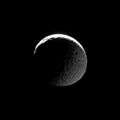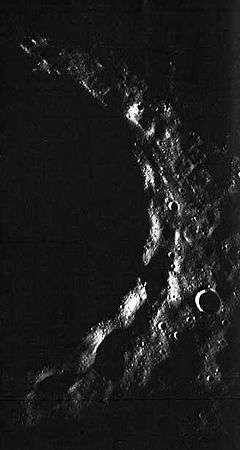Terminator (solar)
A terminator or twilight zone is a moving line that separates the illuminated day side and the dark night side of a planetary body. A terminator is defined as the locus of points on a moon or planet where the line through its sun is tangent.
The Earth's terminator

On Earth, the terminator is a circle with a diameter that is approximately that of the Earth. The terminator passes through any point on the Earth's surface twice a day, at sunrise and once at sunset, apart from polar regions where this only occurs when the point is not experiencing midnight sun or polar night. The circle separates the portion of the Earth experiencing daylight from that experiencing darkness (night). While a little over one half of the Earth is illuminated at any point in time (with exceptions during eclipses), the terminator path varies by time of day due to the rotation of the Earth on its axis. The terminator path also varies by time of year due to the revolution of the Earth around the Sun: the plane of the terminator is nearly parallel to planes created by lines of longitude during the equinoxes, and at its maximum angle of approximately 23.5 degrees to the equator during the solstices.[1]
At the equator, under flat conditions (no obstructions such as mountains; or at a height above any such obstructions), the terminator moves at approximately 1668 kilometers per hour (1036 miles per hour). This speed can appear to increase when near obstructions—such as the height of a mountain, for example—as the shadow of the obstruction will be cast over the ground in advance of the terminator along a flat landscape. The speed of the terminator decreases as it approaches the poles, where it can reach a speed of zero (full-day sunlight or darkness).[2]
Supersonic aircraft like jet fighters or Concorde and Tupolev Tu-144 supersonic transports are the only aircraft able to overtake the maximum speed of the terminator. However, slower vehicles can overtake the terminator at higher latitudes, and it is possible to walk faster than the terminator at the poles, near to the equinoxes. The visual effect is that of seeing the sun rise in the west, or set in the east.
Amateur radio operators take advantage of conditions at the terminator (so-called "gray-line" propagation, or "grey-line" to the British) to perform long distance communications. Under good conditions, radio waves can travel along the terminator to antipodal points. This is primarily because the D layer, which absorbs high frequency signals, disappears rapidly on the dark side of the terminator line. This process is known as skywave propagation.[3]
 A seasonal animation of the terminator line at sunset over central Europe.
A seasonal animation of the terminator line at sunset over central Europe. The transition from light to dark takes place on two fronts in this image of Mimas.
The transition from light to dark takes place on two fronts in this image of Mimas. The orientation of the terminator between the northern and southern hemispheres depends on the season. On the spring and fall equinoxes (around March and September 21), there is no tilt of the Earth with respect to the Sun so the terminator line is parallel with the axis of the Earth and with the lines of longitude.
The orientation of the terminator between the northern and southern hemispheres depends on the season. On the spring and fall equinoxes (around March and September 21), there is no tilt of the Earth with respect to the Sun so the terminator line is parallel with the axis of the Earth and with the lines of longitude.
Lunar terminator


The Lunar terminator is the division between the illuminated and dark parts of the Moon.[4] It is the lunar equivalent of the division between night and day on the Earth's sphere, although the Moon's much lower rate of rotation[5] means it takes longer for it to pass across the surface.
Due to the angle at which sunlight strikes this portion of the moon, shadows cast by craters and other geological features are elongated, thereby making such features more apparent to the observer. This phenomenon is similar to the lengthening of shadows on Earth when the sun is low in the sky. For this reason, much lunar photographic study centers on the illuminated area near the lunar terminator, and the resulting shadows provide accurate descriptions of the terrain.
Lunar terminator illusion
The lunar terminator (or tilt) illusion is an optical illusion arising from the erroneous expectation of an observer on Earth that the direction of light illuminating the moon (i.e. a line perpendicular to the terminator) should correspond with the position of the sun in the sky or a sun which has set, when it does not appear to do so. The cause of the illusion is simply the observer is not taking into account that the observed slope of a light ray will change across the sky because of the lack of visual clues to establish 3D perspective.[6][7]
In popular culture
The lunar terminator features as a plot element in the animated series "Futurama", season 1, episode 2.
Scientific significance
Examination of a terminator can yield information about the surface of a planetary body; for example, the presence of an atmosphere can create a fuzzier terminator. As the particles within an atmosphere are at a higher elevation, the light source can remain visible even after it has set at ground level. These particles scatter the light, reflecting some of it to the ground. Hence, the sky can remain illuminated even after the sun has set.
Low Earth orbit satellites take advantage of the fact that certain polar orbits set near the terminator do not suffer from eclipse, therefore their solar cells are continuously lit by sunlight. Such orbits are called dawn-dusk orbits, a type of Sun-synchronous orbit. This prolongs the operational life of a LEO satellite, as onboard battery life is prolonged. It also enables specific experiments that require minimum interference from the Sun, as the designers can opt to install the relevant sensors on the dark side of the satellite.
See also
References
- ↑ http://sos.noaa.gov/datasets/Land/day_night.html
- ↑ Venus Revealed by David Harry Grinspoon, page 329
- ↑ http://dx.qsl.net/propagation/
- ↑ List of basic lunar features
- ↑ The lunar day cycle is 29.53 Earth days in length (see ), so the terminator moves across the lunar surface at 15.4 kilometers per hour.
- ↑ Jones, Christopher B (January 2014). "Lunar Terminator Illusion". Ellipsis: unfinished thought…. Retrieved 21 May 2016.
- ↑ Myers-Beaghton, Andrea K; Myers, Alan L, The Moon Tilt Illusion (PDF)
External links
| Wikimedia Commons has media related to Terminator. |
- Current terminator
- aa.usno.navy.mil - Website calculating synthetic images (B&W or color) representing the terminator for a given time (date & hour)
- Moon Map
- Shadow Terminator
- The Moon Terminator Illusion (video)